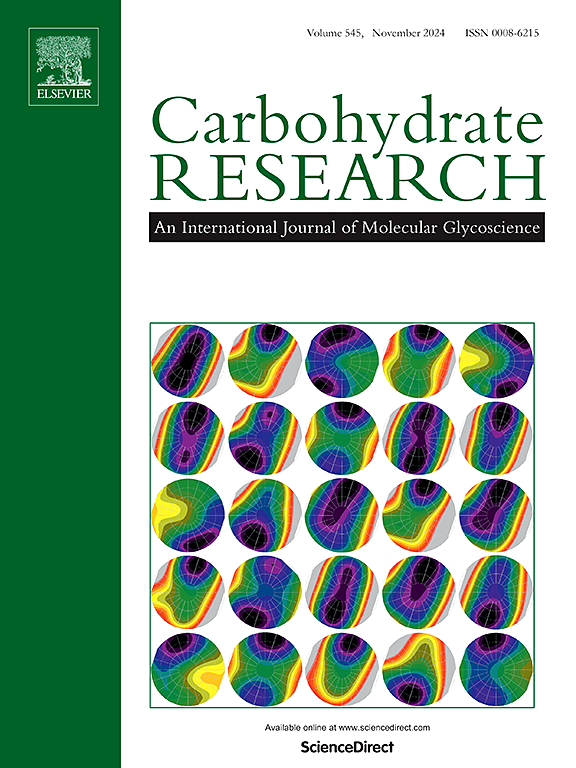详细了解低聚物和聚合物产品形成的三个重组右旋蔗糖酶
IF 2.5
3区 化学
Q3 BIOCHEMISTRY & MOLECULAR BIOLOGY
引用次数: 0
摘要
从乳酸菌中提取的各种葡聚糖蔗糖酶可由蔗糖制备水溶性外聚糖葡聚糖。许多这类酶及其相应的右旋糖酐已经被描述过,但最初形成的产物和延伸成右旋糖酐的化合物尚未被详细表征。因此,我们详细研究了动物乳酸杆菌TMW 1.971 (LaniDSΔN)、罗伊氏乳酸杆菌TMW 1.106 (LreuDSΔN)和唾液链球菌DSM 20560 (SSAL4550)中重组葡聚糖酶在0.25 M和1.5 M蔗糖溶液(含和不含1 M葡萄糖)中形成的低聚物和聚合物产物。蔗糖溶液孵育后,酶主要将蔗糖与1,6-链葡萄糖单位拉长。在蔗糖溶液中,戊二糖和葡萄糖被确定为额外的低分子量化合物,而葡萄糖的加入导致异麦芽糖和曲二糖的优势丰度。HPSEC分析表明,葡萄糖的加入也影响了LaniDSΔN和SSAL4550产生的右旋糖酐的分子量。为了评估哪些产物被用作多糖形成的受体分子,我们对硼氢化还原右旋糖酐的内切右旋糖酐酶水解得到的产物进行了分离、表征和定量。对含葡萄糖醇和含雄蕊糖的低分子量产物的定量分析表明,蔗糖和葡萄糖被用作葡聚糖形成的受体,而蔗糖和曲二糖则没有被拉长。在高葡萄糖浓度下,葡萄糖主要存在于葡聚糖链的非还原端。总之,我们的研究结果提供了不同葡聚糖形成过程的详细见解。本文章由计算机程序翻译,如有差异,请以英文原文为准。

Detailed insights into the oligo- and polymeric products formed by three recombinant dextransucrases
The water-soluble exopolysaccharide dextran can be produced from sucrose by various dextransucrases derived from lactic acid bacteria. Many of these enzymes and their corresponding dextrans have been described, but the initially formed products and the compounds which are elongated to dextrans have not been characterized in detail yet. Therefore, we studied the oligo- and polymeric products formed by recombinant dextransucrases from Ligilactobacillus animalis TMW 1.971 (LaniDSΔN), Limosilactobacillus reuteri TMW 1.106 (LreuDSΔN), and Steptococcus salivarius DSM 20560 (SSAL4550) from 0.25 M and 1.5 M sucrose solutions (with and without 1 M glucose) in detail. After incubation of the sucrose solutions, the enzymes mainly elongated sucrose with 1,6-linked glucose units. Erlose and leucrose were identified as additional low molecular weight compounds in the sucrose solutions, whereas glucose addition led to the predominant abundance of isomalto-oligosaccharides and kojibiose. HPSEC analysis demonstrated that glucose addition also influenced the molecular weight of the dextrans produced by LaniDSΔN and SSAL4550. To evaluate which products were used as an acceptor molecule for polysaccharide formation, the products obtained from endo-dextranase hydrolysis of borohydride reduced dextrans were isolated, characterized, and quantified. The quantification of glucitol-containing and theanderose-containing low molecular weight products demonstrated that sucrose and glucose are used as acceptors for dextran formation, whereas erlose or kojibiose are not elongated. At high glucose concentrations, glucose is mostly found at the non-reducing end of the dextran chain. Altogether, our findings provide detailed insights into the course of dextran formation by different dextransucrases.
求助全文
通过发布文献求助,成功后即可免费获取论文全文。
去求助
来源期刊

Carbohydrate Research
化学-生化与分子生物学
CiteScore
5.00
自引率
3.20%
发文量
183
审稿时长
3.6 weeks
期刊介绍:
Carbohydrate Research publishes reports of original research in the following areas of carbohydrate science: action of enzymes, analytical chemistry, biochemistry (biosynthesis, degradation, structural and functional biochemistry, conformation, molecular recognition, enzyme mechanisms, carbohydrate-processing enzymes, including glycosidases and glycosyltransferases), chemical synthesis, isolation of natural products, physicochemical studies, reactions and their mechanisms, the study of structures and stereochemistry, and technological aspects.
Papers on polysaccharides should have a "molecular" component; that is a paper on new or modified polysaccharides should include structural information and characterization in addition to the usual studies of rheological properties and the like. A paper on a new, naturally occurring polysaccharide should include structural information, defining monosaccharide components and linkage sequence.
Papers devoted wholly or partly to X-ray crystallographic studies, or to computational aspects (molecular mechanics or molecular orbital calculations, simulations via molecular dynamics), will be considered if they meet certain criteria. For computational papers the requirements are that the methods used be specified in sufficient detail to permit replication of the results, and that the conclusions be shown to have relevance to experimental observations - the authors'' own data or data from the literature. Specific directions for the presentation of X-ray data are given below under Results and "discussion".
 求助内容:
求助内容: 应助结果提醒方式:
应助结果提醒方式:


